Updated on January 5, 2023
Welcome to LinkedIn, the land of B2B leads and sales opportunities! At least, that’s what the stats say.
But, are you really enjoying the pleasures out of this promised land?
Here is a short & simple guide to LinkedIn Prospecting to help you get started (and inspired) so you can use the LinkedIn free version to find, contact, and lay the groundwork for a business relationship with your next customer.
Let’s see…
Is LinkedIn good for prospecting?
LinkedIn is where business professionals of all sorts and industries love to hang out virtually, especially nowadays when our physical interactions are quite limited.
(LinkedIn saw a 55% increase in conversations among connections in 2020!)
With nearly 800 million members, LinkedIn has passed the half-billion user mark, making it the world’s largest professional network for connecting B2B buyers and sellers.
And the latest (2022) stats prove it.
– 80% of B2B leads come from LinkedIn (vs. 13% Twitter & 7% Facebook);
– 50% of B2B buyers use LinkedIn as a source for making purchase decisions;
– 4 out of 5 people on LinkedIn “drive business decisions”.
So yes, I think we can conclude that LinkedIn is quite good for Sales Prospecting.
How to use LinkedIn as a prospecting tool?
One of the things I love the most about LinkedIn is that you use your real, full name. It’s one of the rare social media channels where transparency governs and identity matters, while the anonymous gets ignored.
At the same time, that alone is what scares many people off using LinkedIn. Your name has to account for your online behavior and your profile has to portray the person behind that name, professionally and personally.
Yes, it requires you to be open regarding your previous job experience, your current work status, job title, endorsements, recommendations, and such, but if you’re into any type of business, optimizing your LinkedIn profile will only do you good.
When done right, prospecting on LinkedIn can bring you X4 more B2B leads, and more business.
Let’s start with the essentials.
Step #1. Turn your LinkedIn profile into a Lead Generator
To be able to squeeze LinkedIn the right way and extract a juice of ideal prospects and sales potentials, first you’ll need to lay the groundwork for successful LinkedIn prospecting.
Take a professional headshot
Profile photo: It’s the first thing we lay eyes on, everywhere, including LinkedIn.
We want to have a visual representation of the person we’re talking to. So take a high-res. headshot photo where people can clearly see your friendly face. Keep it classy, but relaxed and try to fit all that charm in 500×500 pixels.
p.s. LinkedIn profiles with a photo get 21x more visitors and 36x more messages.
Use Visuals
Cover photo: The part where you mention your business. You don’t have to write big words here, it’s a visual after all. Just placing your logo inside the photo will do the job.
Having in mind that it is a business environment and the second thing we want to know about people on LinkedIn is “where they work?”, this is just you being user friendly. 🙂
Cover photo dimensions: 1584 x 396 pixels.
Write a Killer Headline
LinkedIn Headline: The ice-breaker. These are the very first words they “hear” from you, so make them count.
1. Write your job title here, your niche & industry – place yourself among your business tribe in this huge professional network. It will be easier for the right people to find you and collaborate with you.
2. Add a touch of personality. Whatever brings a spark of joy for you (outside the office), mention it.
3. Lead Magnet. Place soft CTA as an open invitation to connect with you. If they were already looking for the type of assistance you provide, this comes as a warm welcome.
Btw, it’s kind of a big deal to get this right when you know that LinkedIn can generate 3x more conversions than Twitter & Facebook.
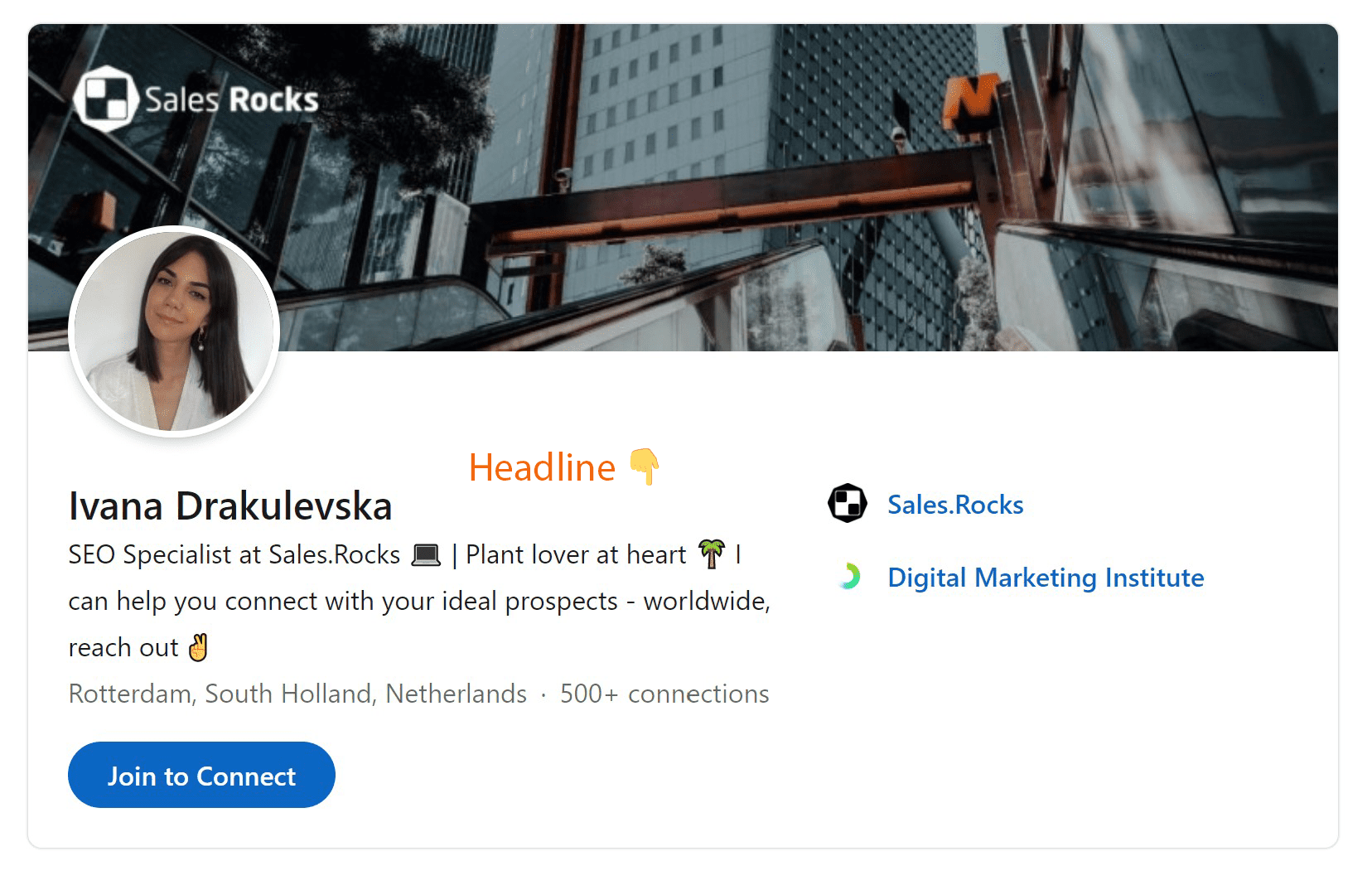
Build Trust and Credibility (by remaining honest).
About: Who are you, in general? What’s your educational background? What have you learned through your professional experience, skills, and achievements? What are you good at? Passionate about? Let your individuality shine through whatever you choose to share about yourself here, and keep it short, sweet, and professional.
Endorsements: It’s great to have them, but they take time and effort to collect. Endorsements act as referrals from the people you’ve collaborated with, but not everybody will remember to endorse you for the great collab unless you remind them to. So don’t hesitate to ask for endorsement or a recommendation, it’s worth it.
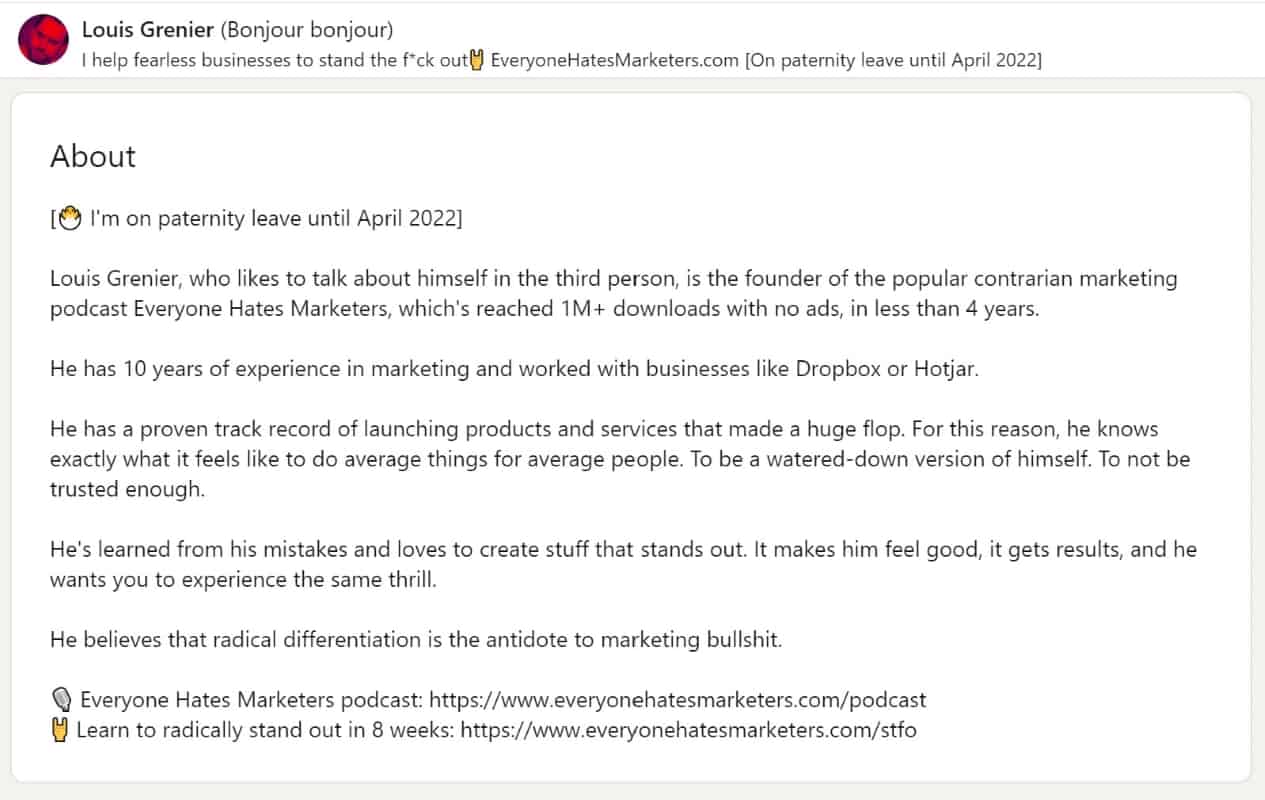
Step #2. Be Social.
And Be Present.
Make it your habit to open LinkedIn every day. Send and accept relevant requests for connections and engage with people’s posts regularly.
Nobody can promise you success with LinkedIn Prospecting if you are not constantly striving to build a strong presence on this business network.
LinkedIn is the number one choice for professionals to gather, to stay connected and informed.
– 46 million B2B decision-makers;
– 17 million opinion leaders;
– 6 million IT decision-makers;
– 40 million mass affluent;
– 10 million C-level execs.
Therefore…
📝 Post relevant content on LinkedIn, regularly.
Remember, we all start with 3 likes, from a friend or a colleague.
Here is how I started one year ago, January 2021.

But patience and perseverance are key.
If you keep going, sharing insights from your field of expertise, and talking about your own experience you’ll see more and more views and engagement on your LinkedIn posts.
Recently, the engagement on one of my posts looked like this.

“Content is the virtual “salesperson” for the long B2B buying cycle.”
Rachel Balik, Sr. Manager Content Marketing, Demandbase.
There is a reason why the most successful B2B SaaS companies understand and nurture the importance of producing high-quality content. They educate and build trust with their B2B buyers through content related to their niche and services and filled with their own experience and industry insights.
🧑🤝🧑 Connect with your community & follow the thought-leaders from your industry.
With a basic (free) LinkedIn account your sales prospecting on LinkedIn is, more or less, limited to your already existing connections.
Why?
Well… unless you’re paying LinkedIn for Sales Navigator or a Premium account (for LinkedIn InMail) it won’t allow you to directly message another LinkedIn member that you’re not connected to.
Therefore, enriching your LinkedIn network with relevant connections (limit: you can send 100 requests a week) and following the industry thought-leaders while engaging with their content will do wonders for your prospecting efforts.
Here are 3 lists to get you started.
20+ LinkedIn Influencers a Sales Person Must Follow in 2022
Follow These Sales Influencers Taking Over 2021
Are You Following These 53 B2B Sales Influencers on LinkedIn?
Then, as you build your network and feed with relevant people, endorse their content as well. Like their posts, share your thoughts or experiences in their comment section, tag a colleague of yours, reshare their posts you find insightful = catch their attention! Let them hear your voice, see your name and come to your profile.
Be social.
Become a member of LinkedIn groups and communities with like-minded business professionals, working in the same industry as you. The chances are, your B2B leads hang out there as well.
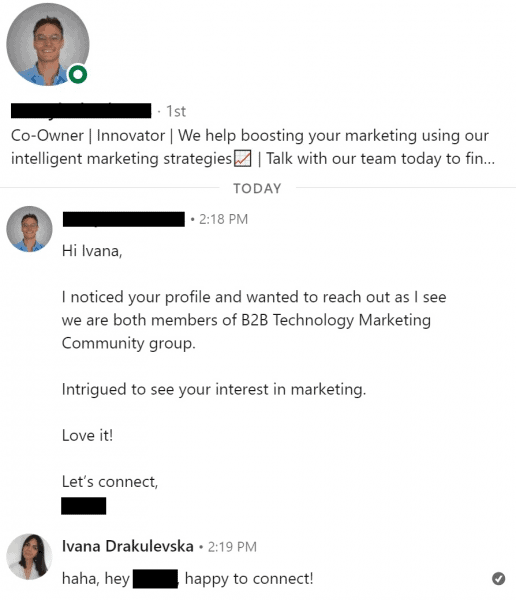
Step #3. Search, Map, and Target your Ideal Prospects
The greatest % of LinkedIn Prospecting efforts fail solely on prospecting the wrong folks.
Not every prospecting company from your target industry will prove to be the right fit for your business offer, or is in need of your solution currently… and that’s fine.
On the other hand, there are companies aware of their need for a certain product, service, or software solution (that you can provide), and would be interested to find out more.
Those are your people. Take the time to draw a rough sketch of your Ideal Customer Profile so you can search for them, find them and then engage them properly.
After all, effective sales prospecting is all about finding the right people and delivering the right information, at the right time.
1. Define your ICP – Ideal Customer Profile
Which companies can benefit the most from your solution?
In what industry do they operate? How long they’ve been in the market?
Can they afford your price? Which department will make the most use out of your product or service?
How many team members it consists of?
Then, you get to the people working in those identified companies, your B2B Buyer Persona.
Who is the decision-maker in the prospecting company that you should reach out to? What are their job title and job roles? What are they interested in currently? How will you start the conversation?
I won’t go into much detail here, since we have already written an extensive article on the subject, feel free to dive in.
2. Use LinkedIn search filters to find new prospects
Whether you are using LinkedIn’s free version, or have upgraded your account to Sales Navigator, the search filters are great if you know how to use them.
However, unless you know exactly WHO you’re after, your search for prospects will be too broad and the results overwhelming, instead of satisfying.
Why connect to people irrelevant to you and your business, while missing the ones that are perfect-fit? That’s why having clearly defined ICP matters.
Get accurate Search Results
When prospecting on LinkedIn for B2B customers, first we start looking for the companies (accounts) that fit our ICP, and then we go after the business professionals and the decision-makers working inside.
Use the ‘industry‘ and ‘company headcount‘ filters when you research for your ideal accounts.
Analyze the company and see if it checks all the relevant marks for being considered a qualified prospect. You don’t want to waste your time on accounts that don’t have a need for your solution yet or simply are not ready to pay the price.
📌 Revenue is not an obligatory field for companies to fill in and update, therefore, don’t place much attention there. On the other hand, full-time employees (measure for Company Size) is an obligatory field on LinkedIn. To get accurate results in your search, use FTEs rather than revenue.
📌 A keyword search for a company page is useful because it allows you to find out exactly what the business does by looking at its description. It’s an effective method of finding things out.
📌 On the other hand, the keyword search for a personal profile, may not give you the most accurate results, because it can pick up on any word in the profile, such as words used on a previous job experience.
e.g. Start your LinkedIn Prospecting by writing a relevant “keyword” to the accounts you want to target.

I chose the keyword “Sales Automation” to open the search tab and filter for Companies in Europe in the Information Technology and Services industry.
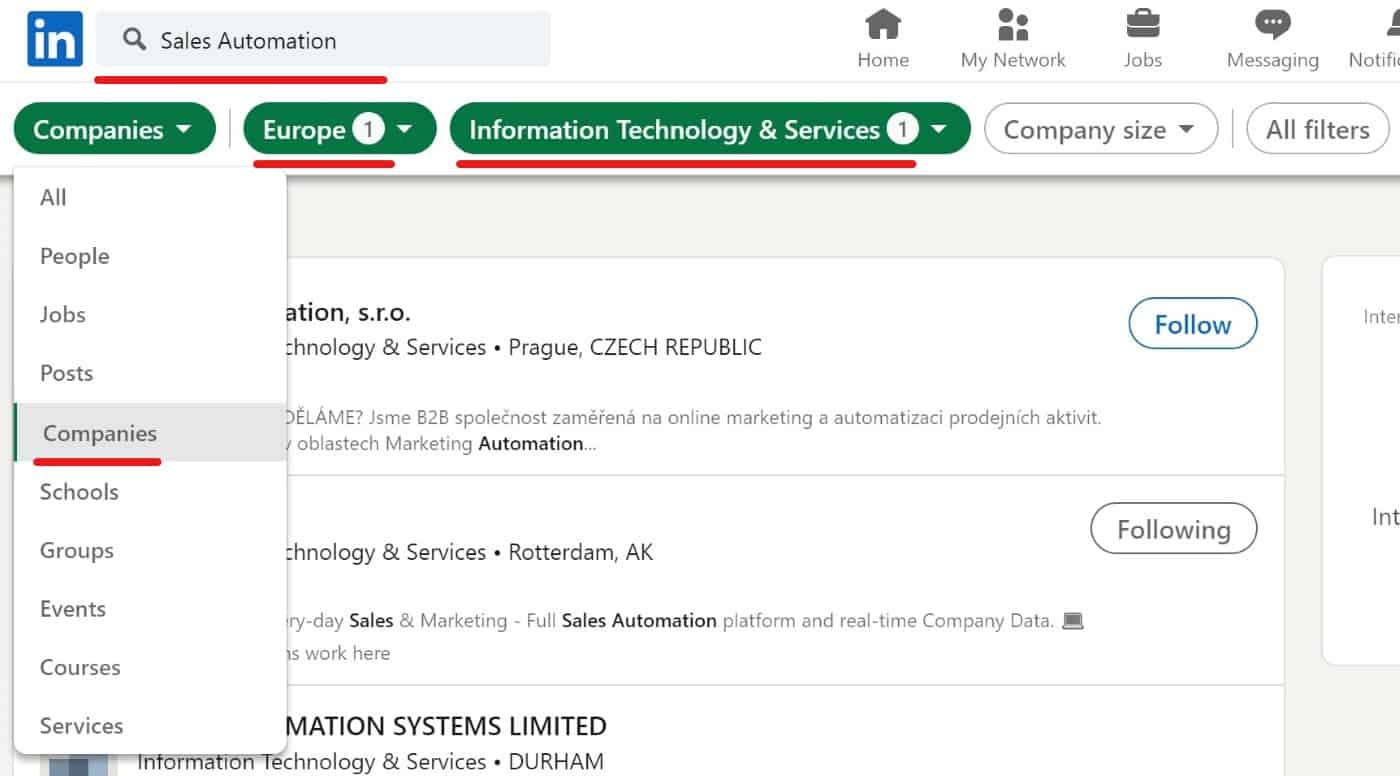
And here are my results using the free version of LinkedIn Search Filters.
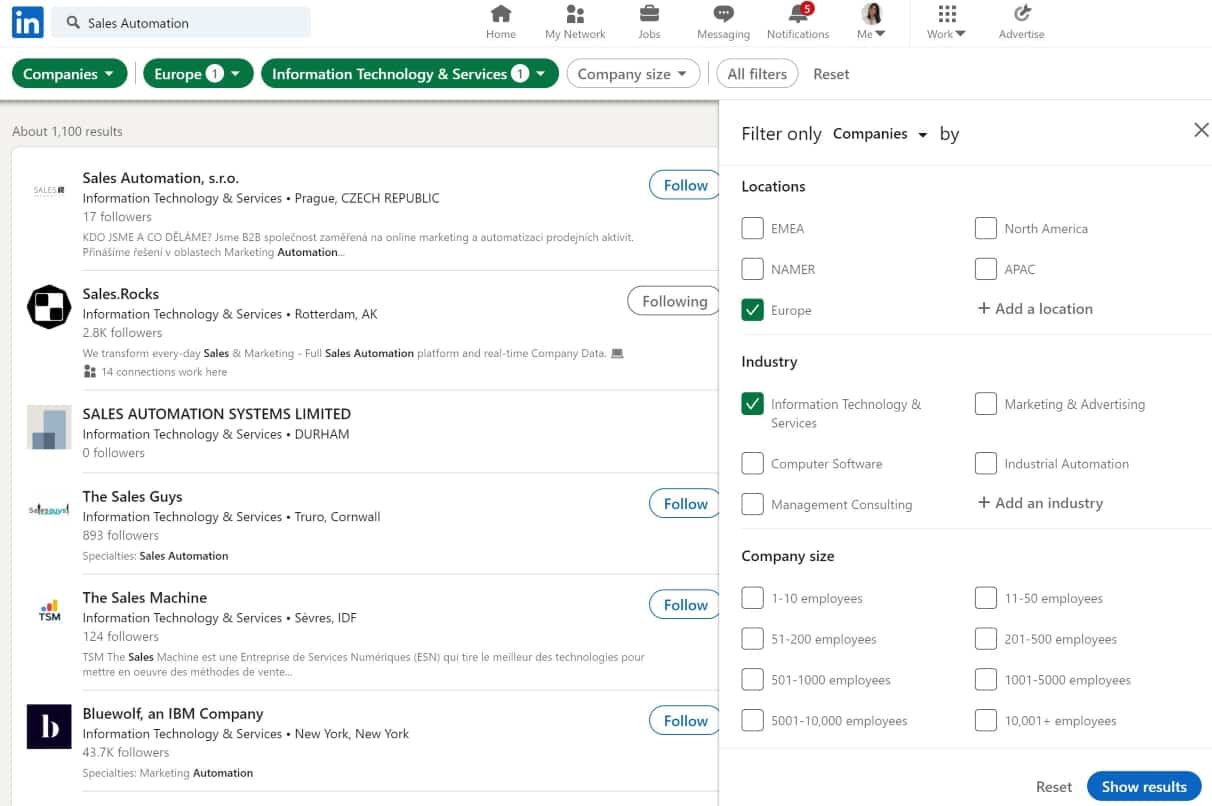
How to use the Boolean Search when prospecting on LinkedIn
Even without Sales Navigator, there is an advanced and efficient way of finding relevant people/ prospects. Use Boolean searches on the free LinkedIn version to get more “refined” results.
e.g. If you type ” “head of sales” OR “chief revenue officer” ” in the search bar when prospecting for your buyer persona, you’ll get results of people who have either the term “head of sales” or “chief revenue officer” in their job title (or anywhere on their profile, including PAST job positions, as we mentioned earlier).
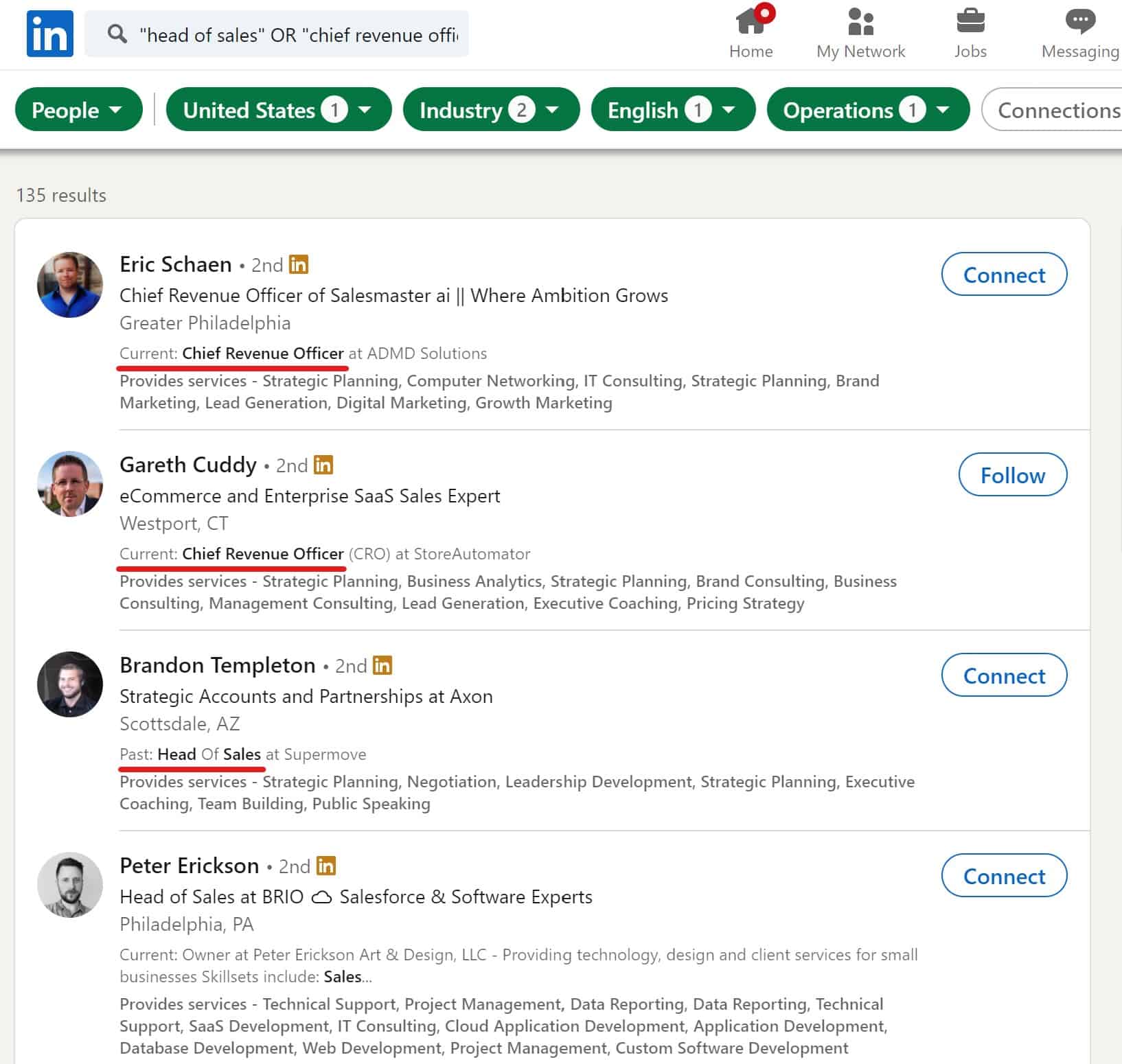
There are a few ways in which you can modify your searches to get the wanted results.
🔍OR: Place OR (all caps) between two keywords and you’ll get “exact match” results with either the 1st keyword or the second keyword
e.g. “head of sales” OR “sales manager” OR “VP of sales”;
🔍AND: Writing AND (all caps) between two words will return results that include all terms in the query
e.g. “B2B” AND “SaaS” AND “Cold Outreach”;
🔍”Quote Marks”: Placing quotes around a key-phrase or string of words returns an exact match for that key-phrase or string of words
e.g.: “Automated Sales Prospecting” / “Email Software for Cold Outreach”;
🔍NOT: Entering NOT or – (a dash) before a word will remove results containing that term.
e.g.: Google NOT AdSense (this returns results of people who worked on other Google projects, like Google+, Google Cloud, Google Analytics, etc., but not Google AdSense;
🔍(Parentheses): Putting ( ) around a function will execute the operators in the command before the ones outside the command
e.g.: “Marketing Manager” AND (Ahrefs OR SemRush);
🔍Asterisk*: The asterisk acts as a placeholder for any word that fits that * place in the phrase.
e.g.: “Chief * Officer” / “Head of *” / “VP of *”
Now that you know how to use the filters for more refined and accurate results, you can get a decent list of prospects for free straight from LinkedIn.
Step #4. Write (the perfect) cold LinkedIn outreach template
Now that you found them, let’s take a look at how you can approach your prospects on LinkedIn in a meaningful way so that you start building a business relationship with them and lay the groundwork for inviting them inside your sales process.
Personalize your cold LinkedIn outreach
When writing messages for your prospects, your level of personalization will determine the success of your overall Cold LinkedIn Outreach campaign.
Not every prospect on your list will have the same pain points, goals, objectives, or needs that your solution can help them with. You’ll need to figure out who to target, how to address them, and what exactly they will benefit the most from your range of products, features, or services?
Therefore, take the time to do proper research and wrap your cold messages into a meaningful context for each of your potential customers, if you want to see an increase in response rate.
Recently, we wrote an article on how to write the ideal sales email in a few simple steps. It is filled with tips and hacks to help you compose an overall great sales message which you can then use as a template for your cold LinkedIn outreach as well.
How to Write a Sales Message?
Cheat Sheet for SDRs
Step #5. Follow the LinkedIn rules for outreach (to avoid getting banned).
Before you start your cold LinkedIn Outreach to prospects, make sure you understand and you follow the most important LinkedIn rules for not getting blocked or banned from the platform.
Your LinkedIn prospecting above all depends on the reputation of your LinkedIn account. And when it comes to the success of your outbound sales process on LinkedIn you need to focus on several key areas that will ensure your effort doesn’t go to waste.
- Warm-up your LinkedIn account before doing serious outreach
- Choose carefully who you connect with on LinkedIn
- Make each LinkedIn invite count, don’t waste them
- Send cold messages on LinkedIn, without using InMail credits
- Make your LinkedIn search accurate and targeted
- The LinkedIn Premium workaround
Read more in detail about each of these steps in this article: How to do LinkedIn Outreach and not get blocked
Good luck with your LinkedIn Prospecting!
Now that you know all the essentials, you have the insights to run the whole process smoothly and reach, influence, and win over your target accounts and decision-makers. However, if you stumble upon any obstacle, or have a question that we haven’t discussed here, feel free to ping us on LinkedIn.
Until next time. ✌️
Join Sales.Rocks Community!
Jump on a call with our team to see if we are a fit for each other


